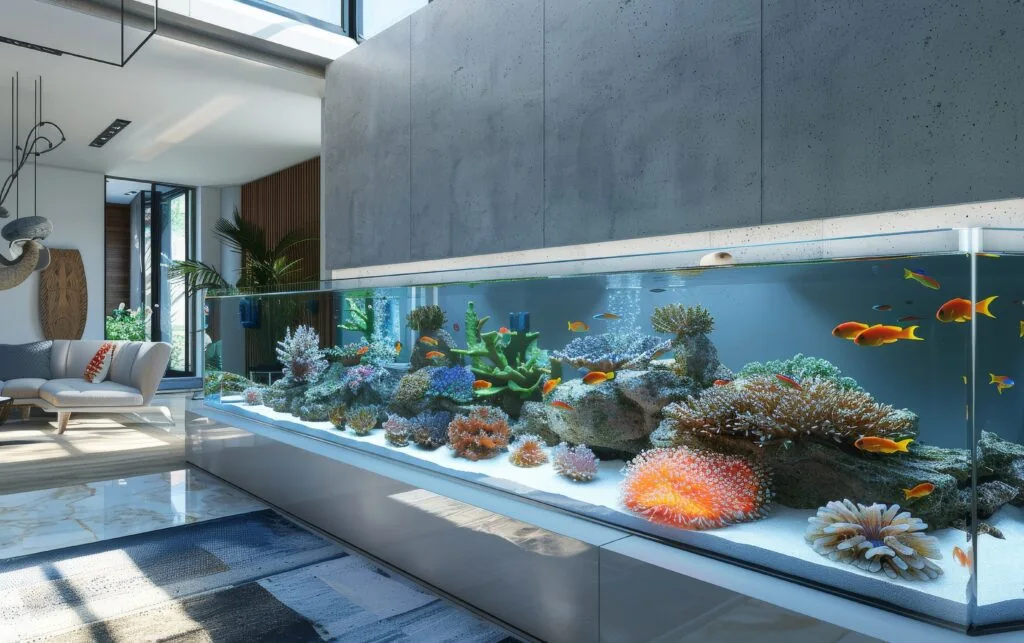Waterbox Aquariums – Must Read Before You Buy

Waterbox aquariums offer an exceptional choice for both beginners and seasoned aquarists alike.
Tetra Guide provides this comprehensive overview, covering everything from the high-quality materials that set Waterbox aquariums apart to the various types available, including freshwater and saltwater options.
It also explores essential equipment, setup tips, and common pitfalls to avoid. Whether you’re aiming for a stunning reef or a vibrant freshwater display, this guide will provide the insights you need.
Key Takeaways:
- High quality materials and a wide range of sizes and options make Waterbox Aquariums a top choice for fish enthusiasts.
- Tetra Guide offers unique insights and expertise on Waterbox Aquariums, helping users make informed decisions.
- Properly sizing and maintaining a Waterbox Aquarium is crucial, and requires the right equipment and avoidance of common mistakes.
What Are Waterbox Aquariums?
.jpg_00.jpeg)
Waterbox aquariums are a premium choice for both novice and experienced aquarists, offering a variety of rimless tank designs that combine aesthetics with functionality.
Tetra Guide provides this comprehensive guide to help users navigate through different options available, emphasizing the quality and craftsmanship behind each aquarium model. From small nano tanks to larger displays, Waterbox aquariums cater to a wide range of preferences and needs, ensuring a seamless fit in any home or office setting.
This guide will delve into the unique features, benefits, and the reputation of Waterbox aquariums, providing insights that go beyond mere specifications.
Why Choose Waterbox Rimless Aquariums?
Choosing Waterbox aquariums is a decision backed by quality, versatility, and positive customer feedback, making them an excellent investment for both beginners and seasoned aquarists.
Tetra Guide thoroughly reviews Waterbox aquariums to inform you about their unique attributes, ensuring you understand what makes them stand out in the crowded aquarium market.
The combination of elegant design and practical features ensures that every tank serves its purpose, whether for freshwater, saltwater, or reef setups. This section will explore the reasons one might consider these aquariums, emphasizing quality, reputation, and user experiences.
High Quality Materials
One of the key attributes of Waterbox aquariums is the use of high-quality materials, which not only ensure durability but also enhance the overall aesthetic appeal of a rimless aquarium setup.
These materials contribute to the structural integrity and longevity of the tanks, making them ideal for both freshwater and saltwater environments.
Waterbox employs various materials, including low-iron glass and advanced silicone bonding, which serve to create an unobstructed viewing experience, capturing the beauty of aquatic life without distortion.
By utilizing low-iron glass, the tanks allow for remarkable light penetration, which is essential for marine and plant growth, thus fostering a healthy ecosystem.
- Durability: The high-quality construction ensures that the tanks withstand pressure and minimize the risk of breakage.
- Aesthetic Appeal: The clear glass edges eliminate the need for bulky frames, leading to a sleek, modern look.
- Ease of Maintenance: The materials are not just sturdy; they also make cleaning hassle-free, allowing owners to focus on their aquatic inhabitants.
This thoughtful choice of materials exemplifies how a rimless aquarium can be both functional and visually stunning, enriching any living space with the tranquility of an underwater retreat.
Wide Range of Sizes and Options
Waterbox aquariums offer a wide range of sizes and options, catering to various preferences and space constraints, from compact rimless tanks to expansive displays. This versatility allows aquarists to select the perfect aquarium that suits their individual needs and the aquatic life they wish to house.
With a variety of aquarium sizes available, it’s easy for both beginners and seasoned enthusiasts to find the right fit. Whether seeking a minimalist desktop setup or a grand centerpiece for a living room, the choices are abundant.
Each configuration is crafted with care, ensuring that the layout supports the health and growth of aquatic species while enhancing the overall aesthetic.
- Compact Rimless Tanks: Ideal for limited spaces, these tanks are perfect for small-scale aquatic displays.
- Mid-Size Aquariums: A versatile option that provides ample room for a variety of fish and plants.
- Large Show Tanks: Designed for those who want to create a stunning focal point in their home or office.
By exploring these options, aquarists can find rimless tanks that not only match their housing requirements but also complement their lifestyle.
Unique Insights from Tetra Guide
Tetra Guide provides unique insights and expert advice on Waterbox aquariums, ensuring that users have access to comprehensive information tailored to their needs. These insights are invaluable for potential buyers, helping them to make informed decisions based on real-world experience and deep understanding of the product.
The guide also emphasizes the importance of selecting the right components, such as lighting and filtration systems, which can greatly enhance the user experience. By following the recommendations provided, aquarium enthusiasts can create a sustainable environment that not only supports aquatic life but also cultivates an aesthetic appeal in their homes.
- Choose appropriate lighting for growth and vibrancy.
- Implement a reliable filtration system to maintain water quality.
- Consider the aquatic species and their specific requirements.
With a blend of technical knowledge and practical tips, users are better equipped to embark on their Waterbox aquariumjourney, ensuring a thriving ecosystem that flourishes over time.
What Are The Different Types of Waterbox Aquariums?
Waterbox aquariums are available in various types, each designed for specific aquatic environments and preferences, including options for freshwater, saltwater, and rimless designs. Understanding these differences is crucial for aquarists to choose the right aquarium that fits their requirements. From vibrant freshwater setups to intricate reef-ready saltwater tanks, Waterbox provides a range of solutions for all levels of hobbyists.
Freshwater vs. Saltwater
.jpg_01.jpeg)
When considering Waterbox aquariums, one must decide between freshwater and saltwater options, as each type caters to different ecosystems and aquatic life. Freshwater setups are often easier to maintain, while saltwater aquariums offer stunning diversity and vibrant colors but can require more care and expertise.
When diving deeper into aquarium ecosystems, enthusiasts discover that freshwater tanks can host a variety of species such as tetras, guppies, and angelfish, which thrive in simpler water conditions.
On the other hand, saltwater configurations boast scattered inhabitants like clownfish, corals, and anemones that flourish in more complex environments, often necessitating advanced filtration and lighting systems.
- Benefits of Freshwater: Lower cost and simpler maintenance.
- Challenges of Freshwater: Limited species variety compared to saltwater.
- Benefits of Saltwater: Rich biodiversity and visually captivating displays.
- Challenges of Saltwater: Higher initial setup costs and more intensive care.
Choosing among the various Waterbox options enhances the possibility of creating a stunning aquatic scene tailored to individual preferences and capabilities.
Standard vs. Reef Ready
Waterbox aquariums can be categorized into standard and reef-ready models, each designed with specific functionalities to support different types of aquatic life. Standard aquariums are versatile for various freshwater species, while reef-ready options are specially equipped for saltwater setups, promoting the growth of coral and other marine organisms.
When considering the choice between these two types, it’s essential to recognize the distinctive features they offer.
For example, while standard models are typically designed with a simpler filtration system suitable for freshwater environments, reef-ready aquariums boast advanced filtration to handle the more demanding needs of marine ecosystems. This includes:
- High-quality protein skimmers that effectively remove organic waste.
- Specialized sumps providing better water management.
- Robust lighting systems tailored for thriving coral growth, including full-spectrum LED options.
The build quality of reef-ready Waterbox aquariums emphasizes durability, ensuring long-lasting support for delicate aquatic life. Understanding these differences will enable aquarists to choose the most suitable setup for their unique hobbyist goals.
Rimless vs. Traditional
The choice between rimless and traditional aquariums is significant for hobbyists, as it affects both aesthetics and functionality. Rimless aquariums, known for their sleek, modern look, provide unobstructed views of aquatic life, while traditional tanks may offer additional structural support and versatility.
Regarding selecting the perfect aquarium, the decision often boils down to personal preference and specific needs. Rimless tanks, such as those offered by Waterbox aquariums, are popular options to consider.
- Aesthetics: Rimless aquariums create an elegant, minimalist design that seamlessly integrates into any home decor, captivating those who prioritize style.
- Functionality: Traditional aquariums might appeal to users seeking reliability and greater options for equipment installation, providing more stability.
- Maintenance: Rimless tanks tend to require careful planning to prevent water evaporation, while traditional tanks often have lids that help maintain water levels.
- Cost: Although rimless designs may come at a premium, traditional models frequently allow for a wider range of budget options.
Ultimately, the choice should reflect the user’s preferences, lifestyle, and the desired impact of the aquarium in their space. Consulting a comprehensive Waterbox aquariums review can provide valuable insights and help make an informed decision.
What Size Waterbox Aquarium Should You Choose?
Selecting the appropriate size for your Waterbox aquarium is vital, as it influences the overall success of your aquatic environment. Rimless tanks offered by Waterbox aquariums come in various sizes to suit different needs and spaces.
Factors such as tank dimensions, the type of aquatic life, and available space will all play a crucial role in this decision. Understanding the needs of various fish species can also guide you in making the right choice. A detailed Waterbox aquariums review often highlights these considerations, helping you make an informed decision.
Factors to Consider
When choosing the size of your Waterbox aquarium, several factors must be considered, including available space, the type of aquatic life you wish to keep, and your maintenance capabilities.
Each of these factors will significantly influence the overall health and happiness of your aquarium inhabitants. Waterbox aquariums, especially their rimless tanks, offer versatile options that cater to different requirements.
Determining the size selection is crucial, as it directly impacts tank placement. Think about the space in your home; whether it’s a cozy corner or an expansive area, the dimensions of the aquarium must fit seamlessly into the environment.
The species compatibility should be considered, as some fish require more room to swim and thrive. It’s essential to look into the specifics of each aquatic life you plan to keep, including their space needs and social behaviors.
Think about your maintenance abilities; larger tanks generally provide more stable environments but require more upkeep. Regular water changes, cleaning, and monitoring are vital, so ensure you have the time and resources to maintain your chosen aquarium size effectively.
- Assess available space
- Understand species needs
- Evaluate maintenance capacity
Recommended Sizes for Different Fish Species
Different fish species will thrive in varying sizes of Waterbox aquariums, making it essential to match the right tank dimensions with the aquatic needs of your selected species. Understanding the minimum and optimal tank sizes for popular fish can greatly influence their health and well-being.
When setting up an aquarium, it’s important to consider not just the size, but also the compatibility of different species. Each fish has its unique requirements, and the recommended sizes often vary widely depending on the type.
- Small Fish: Fish like guppies and neon tetras thrive in a 10-20 gallon tank.
- Medium Fish: Species such as angelfish might be best suited to 30-40 gallon setups to provide ample swimming space.
- Large Fish: For larger varieties like oscars, a minimum of 75 gallons is suggested to ensure their comfort and health.
By understanding these recommendations and observing each fish’s behavior, enthusiasts can create a harmonious aquatic environment that meets the diverse aquatic needs of their finned friends.
What Is The Essential Equipment for Waterbox Aquariums?
To create a healthy and thriving environment for aquatic life, understanding the essential equipment needed for a Waterbox aquarium is crucial. Proper filtration, lighting, heating, and substrate are foundational elements that play a significant role in maintaining water quality and providing a suitable habitat for your fish or corals.
Filtration System
A high-quality filtration system is vital for any Waterbox aquarium, as it significantly impacts water quality and the overall health of your aquatic inhabitants. Effective filtration ensures that harmful toxins are removed and maintains a stable environment for fish, plants, and corals.
In choosing the right filtration system, aquarium owners have several options, including canister filters, hang-on-back (HOB) filters, and internal filters. Each type comes with its own set of advantages:
- Canister filters are known for their powerful flow rates and multi-stage filtration capabilities, making them ideal for large or heavily stocked tanks.
- Hang-on-back filters provide ease of maintenance and installation, making them suitable for beginners or smaller aquariums.
- Internal filters are compact, taking up minimal space while providing adequate filtration for smaller setups.
Utilizing any of these systems can effectively enhance water quality by ensuring optimal circulation, removing debris, and breaking down harmful substances. Ultimately, a suitable filtration system not only supports aquatic life but also makes aquarium maintenance more manageable.
Lighting
Proper lighting is essential for the health and well-being of fish and plants in a Waterbox aquarium, as it supports photosynthesis and enhances the tank’s aesthetic appeal. Choosing the right lighting system tailored to your aquatic life will ensure a vibrant and thriving aquarium environment.
To achieve the best results, one should explore a variety of lighting options tailored to specific needs. For instance, LED systems are popular due to their efficiency and adjustable spectrum, making them suitable for both freshwater and saltwater setups.
- Plant growth: Bright, full-spectrum lights are crucial for plants, ensuring they receive the necessary wavelengths for optimal growth.
- Fish behavior: Different species may react positively or negatively to certain light intensities, highlighting the importance of choosing an appropriate system.
- Customization: Some lighting fixtures even allow for programmable settings, catering to daily light cycles that mimic natural environments.
In essence, understanding the various lighting choices available directly contributes to the overall aquarium health of any Waterbox aquarium.
Heating
Maintaining appropriate water temperature is crucial for the health of aquatic life in Waterbox aquariums, and a reliable heating system is essential for this purpose. Many Waterbox aquariums review articles emphasize the importance of consistent temperature control to ensure a thriving aquatic environment. Proper temperature control ensures that fish and corals thrive in a stable environment, avoiding stress and potential health issues.
In fact, a well-functioning heating system is one of the cornerstones of a successful aquatic ecosystem. These systems come in various types, each designed to cater to the specific needs of different aquatic inhabitants. Heating systems can be categorized into:
- Submersible Heaters: These devices heat the water directly, making them a popular choice for their efficiency and ease of use.
- Inline Heaters: Positioned outside the tank, these are perfect for larger setups, offering precise temperature control without taking up space inside the aquarium.
- Integrated Systems: Built directly into the aquarium, these provide a sleek, space-saving solution.
Regardless of the type, ensuring the right heater is used contributes significantly to stability, promoting a healthier habitat where aquatic life can flourish. This is often highlighted in Waterbox aquariums review articles, which provide detailed evaluations of different heaters and their performance.
Substrate and Decorations
The choice of substrate and decorations in a Waterbox aquarium is not only an aesthetic consideration but also plays a role in the overall health of the ecosystem. The right substrate supports beneficial bacteria, while decorations provide hiding spots and enrich the habitat for fish and invertebrates.
When selecting the ideal substrate for a Waterbox aquarium, one can consider options like sand, gravel, or specialized soil. Detailed Waterbox aquariums reviews can provide guidance on the best substrates for different types of setups. Each type offers unique benefits that cater to different aquatic needs and aesthetic preferences. For instance, sandy substrates are particularly appealing in marine setups, as they mimic natural shorelines.
- Gravel is versatile and encourages excellent water circulation while supporting a variety of plants in Waterbox aquariums.
- Soil substrates, enriched with nutrients, promote healthy plant growth, enhancing the overall aesthetics of the aquarium, including popular rimless tanks.
- Decorative elements such as rocks, driftwood, and artificial plants not only enhance the visual appeal but also serve as refuge spaces for aquatic inhabitants.
Consideration of both aesthetics and functionality ensures a well-rounded environment for all species involved, promoting a thriving ecosystem within the Waterbox aquarium. For more insights, you might check a detailed Waterbox aquariums review to see how these elements work in harmony.
How To Set Up and Maintain Waterbox Aquariums?
.jpg_11.jpeg)
Setting up and maintaining a Waterbox aquarium requires careful planning and adherence to best practices for optimal results. From selecting the right equipment and establishing the tank ecosystem to regular maintenance routines, understanding these steps will ensure a thriving aquatic environment for your fish and plants.
Step-by-Step Guide
A step-by-step guide to setting up your Waterbox aquariums will provide you with all the necessary information to create a successful aquatic environment. Following these structured steps can help you avoid common pitfalls and ensure a smooth transition into aquarium ownership.
Before diving into the setup, it’s crucial to choose the right location for your aquarium. Ideally, find a spot away from direct sunlight to minimize algae growth. Ensure the surface can support the weight of the filled tank and is accessible for maintenance. Once you’ve settled on a location,
- begin by unpacking your equipment carefully, including the filtration system, heater, and lighting.
- Install the filtration system and heater according to the manufacturer’s instructions, ensuring all connections are secure.
- Fill the aquarium with treated water up to the recommended level.
- Afterward, it’s time to cycle your aquarium, which allows beneficial bacteria to establish. Start by adding a bacterial supplement or fish food to kickstart the process.
This foundational step not only sets the stage for a healthier aquatic environment but also ensures that you can enjoy your new hobby without complications.
Tips for Proper Maintenance
Proper maintenance is crucial for the long-term success of your Waterbox aquarium, ensuring that water quality remains high and aquatic life thrives. Regular maintenance routines can prevent common issues and enhance the overall aesthetic of your aquarium.
To effectively care for your setup, it is essential to implement a series of straightforward yet effective maintenance tips. Frequent water changes should be prioritized, ideally every two weeks, to keep the tanks clean and reduce contaminants that can disturb the delicate balance of water chemistry. In addition, regularly checking equipment such as filters, heaters, and pumps is vital, ensuring they are functioning optimally and contributing positively to the environment.
- Monitor water parameters using reliable test kits to ensure vital levels such as pH, ammonia, and nitrate are stable.
- Evaluate the condition of plants and decorations, removing any decaying organic matter.
- Clean algae buildup efficiently without disrupting the habitat for its inhabitants.
By following these fundamental maintenance tips, aquarium owners can create not only a visually appealing display but also a peaceful sanctuary for their aquatic pets.
What Are Some Common Mistakes to Avoid with Waterbox Aquariums?
Avoiding common mistakes with Waterbox aquariums is vital for ensuring a healthy and thriving aquatic environment. Many new aquarists may overlook key aspects such as overstocking, proper cycling, and regular water changes, which can lead to stress and illness among fish and plants.
Overstocking the Tank
Overstocking a Waterbox aquarium is a frequent mistake that new aquarists make, often leading to stress and poor water quality. Understanding tank capacity and the needs of your aquatic life is essential for maintaining balance and health in your aquarium ecosystem.
When a tank is overcrowded, it can result in insufficient oxygen levels and an increase in ammonia levels, which directly jeopardizes fish health. In essence, each fish requires a certain amount of space not just for swimming, but also to establish territories and avoid conflicts.
The implications are clear:
- Poor water quality: Overstocking leads to higher levels of waste accumulation, which diminishes the overall quality of the water.
- Increased stress: Fish that feel cramped are likely to exhibit stress-related behaviors, which can compromise their immune systems.
- Biological imbalance: Essential bacteria needed for breaking down waste may struggle to keep up with the overload, affecting the nitrogen cycle.
Thus, understanding the specific tank capacity for your Waterbox aquariums is not merely a suggestion; it’s a crucial component of successful aquatic management.
Not Properly Cycling the Tank
Not properly cycling a Waterbox aquarium is a critical mistake that can lead to ammonia spikes and the death of sensitive aquatic life. Understanding the nitrogen cycle and how to establish beneficial bacteria is essential for a stable and healthy environment.
To effectively navigate the cycling process, it’s crucial to grasp the roles of nitrogenous compounds in the water. The nitrogen cycle involves a series of steps that convert harmful ammonia into safer nitrates, facilitating a balanced ecosystem.
- Initially, when fish waste and uneaten food decompose, they produce ammonia.
- This toxic substance is then converted into nitrites by beneficial bacteria.
- Eventually, another set of bacteria transforms nitrites into less harmful nitrates.
To establish this cycle properly, maintaining a consistent temperature and ensuring adequate oxygen levels are vital. Conducting regular tests for ammonia, nitrite, and nitrate levels not only aids in monitoring progress but also ensures optimal conditions for your aquatic life. With patience and vigilance, one can cultivate a thriving underwater paradise.
Neglecting Water Changes
Neglecting regular water changes is another common mistake that can jeopardize the health of your Waterbox aquarium. Routine water changes are essential for removing toxins, replenishing essential minerals, and maintaining a balanced ecosystem.
Without regular maintenance, harmful substances can build up in the water, leading to unhealthy conditions for aquatic life. Generally, it is recommended to perform water changes every 1-2 weeks, adjusting as necessary based on tank size and bio-load. Aim to replace about 10-20% of the water during these changes to keep the levels stable and avoid shocking your aquatic inhabitants.
- Changing water regularly helps to:
- Eliminate nitrate and phosphate buildup.
- Stabilize pH levels.
- Replenish important trace elements.
Establishing a consistent schedule not only promotes a thriving environment but also makes maintenance more manageable over time.
Waterbox Aquariums Wrap Up
.jpg_10.jpeg)
Waterbox aquariums represent a top-tier choice for both beginners and experienced aquarists, offering a blend of quality, versatility, and aesthetic appeal.
This guide has highlighted essential aspects of selecting and maintaining these rimless tanks, emphasizing the importance of considering factors such as sizes, types, and materials used.
As you embark on your aquarium journey, applying the knowledge gained here will ensure a thriving aquatic environment that reflects your personal taste and care.
Understanding Waterbox aquariums means recognizing their intricate design coupled with functional elegance. For novices, adhering to guidelines from a Waterbox aquariums review can be exceptionally helpful.
- best practices in tank setup
- water chemistry management
- regular maintenance schedules
Adhering to this will pave the way for a successful aquarium experience. Selecting suitable filtration systems and lighting tailored to specific aquatic life not only enhances the tank’s aesthetics but also promotes overall health within the ecosystem.
By staying informed about your aquarium’s specific needs, you can ensure that the vibrant environment remains sustainable, fulfilling, and beautiful for years to come.
Frequently Asked Questions
What are Waterbox aquariums and why are they popular?
Waterbox aquariums are high-quality, glass aquariums designed for fish keeping. They are popular among fish enthusiasts for their sleek design, durability, and ease of use.
What are the different options available for Waterbox aquariums?
Waterbox aquariums come in a variety of sizes and styles, including rimless, all-in-one, and traditional designs. They also offer different filtration systems, such as sumps and hang-on-back filters.
What sets Waterbox aquariums apart from other brands?
Waterbox aquariums are known for their attention to detail and use of high-quality materials. They also offer a range of customizable options, such as different glass thickness and overflow designs.
Are Waterbox aquariums suitable for beginners?
Yes, Waterbox aquariums are a great option for beginners due to their user-friendly design and easy setup. They also offer helpful resources and guides for new fish keepers.
How often should I clean my Waterbox aquarium?
It is recommended to clean your Waterbox aquarium at least once a week, or more frequently if needed. Regular maintenance, such as water changes and filter cleanings, is important for the health of your fish.
Can I use any type of fish in a Waterbox aquarium?
Waterbox aquariums are suitable for a wide range of freshwater and saltwater fish. However, it is important to research the specific needs of the fish you plan to keep before adding them to your aquarium.
Share Your Tetra Experiences
Do you have any stories or tips about your Tetra tank? Share them in the comments below!
Help Others Discover This Guide
Navigate the Tetra in your tank with confidence. This guide is your pathway to creating a vibrant and healthy aquatic showcase. Enjoy the dazzling colors and lively nature of these unique fish!





